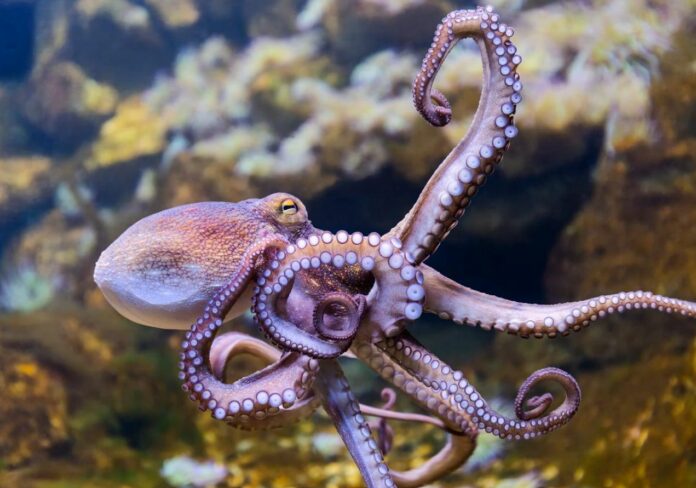Octopuses exhibit a fascinating sleep pattern characterized by brief periods of frenetic activity amidst their tranquil slumber. During these active sleep phases, their arms and eyes twitch, their breathing quickens, and their skin displays vivid colors.
A recent study conducted by researchers from the Okinawa Institute of Science and Technology (OIST) in collaboration with the University of Washington closely examined the brain activity and skin patterns of Octopus laqueus during this active sleep phase.
Surprisingly, they discovered that the neural activity and skin patterning closely resemble those observed when the octopuses are awake.
This wake-like activity is reminiscent of the rapid eye movement (REM) sleep stage in mammals, which is associated with dreaming.
Published in Nature today, the study sheds light on the remarkable similarities in sleep behavior between octopuses and humans, providing intriguing insights into the origins and functions of sleep.
“All animals seem to show some form of sleep, even simple animals like jellyfish and fruit flies. But for a long time, only vertebrates were known to cycle between two different sleep stages,” explained Professor Sam Reiter, the senior author leading the Computational Neuroethology Unit at OIST.
The fact that two-stage sleep has independently evolved in distantly related creatures like octopuses, which possess large but distinct brain structures compared to vertebrates, suggests that having an active, wake-like stage may be a fundamental characteristic of complex cognition, as explained by Dr. Leenoy Meshulam, a statistical physicist at the University of Washington and an author involved in the research while participating in the Theoretical Sciences Visiting Program at OIST.
Initially, they verified whether the octopuses were genuinely asleep during the active period. They tested their response to physical stimuli and observed that, during both the quiet and active stages of sleep, the octopuses required stronger stimulation before reacting compared to when they were awake. Additionally, the team discovered that if they prevented the octopuses from sleeping or disrupted their active sleep phase, the octopuses would enter active sleep more frequently and at an earlier time.
“This compensatory behavior nails down the active stage as being an essential stage of sleep that is needed for octopuses to properly function,” remarked Aditi Pophale, co-first author of the study and a PhD student at OIST.
The researchers also delved into the brain activity of the octopuses during wakefulness and sleep. During quiet sleep, they observed distinct brain waves known as sleep spindles, similar to those seen in non-REM sleep in mammalian brains. These sleep spindle-like waveforms are believed to play a role in memory consolidation, although their exact function remains unclear even in humans. Using an advanced microscope developed by co-first author Dr. Tomoyuki Mano, the researchers discovered that these sleep spindle-like waves occur in regions of the octopuses’ brains associated with learning and memory, suggesting a potential similarity to humans.
Approximately once per hour, the octopuses entered an active sleep phase lasting around a minute. During this phase, the octopuses’ brain activity closely resembled their wakeful brain activity, much like REM sleep in humans.
The research team also captured and analyzed the changing patterns of the octopuses’ skin, both when they were awake and asleep, using an ultra-high 8K resolution.
“By filming in such high resolution, we can see how each individual pigmented cell behaves in order to create an overall skin pattern,” Dr. Meshulam added. “This could help us create simple skin pattern models to understand the general principles of waking and sleeping patterning behavior.”
When the octopuses were awake, they controlled thousands of small pigmented cells in their skin, resulting in a wide range of diverse skin patterns. These patterns served various purposes, including camouflage in different environments, as well as social or defensive displays such as deterring predators or communicating with conspecifics. During active sleep, the researchers observed that the octopuses cycled through these same skin patterns.
The similarities between active sleep and wakefulness in the octopuses could be attributed to several factors, according to the scientists. One theory suggests that octopuses may be practicing their skin patterns to improve their camouflage behavior while awake or simply maintaining the pigment cells.
Another intriguing idea is that the octopuses could be re-experiencing and learning from their wakeful experiences, such as hunting or evading predators, by reactivating the skin patterns associated with each experience. In essence, they might be engaging in a form of dreaming.
“In this sense, while humans can verbally report what kind of dreams they had only once they wake, the octopuses’ skin pattern acts as a visual readout of their brain activity during sleep,” noted Prof. Reiter.
He further added, “We currently don’t know which of these explanations, if any, could be correct. We are very interested in investigating further.”
Image Credit: Shutterstock
